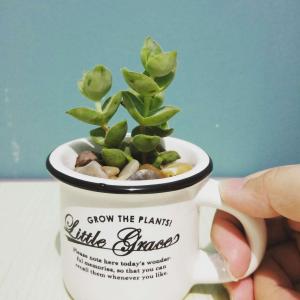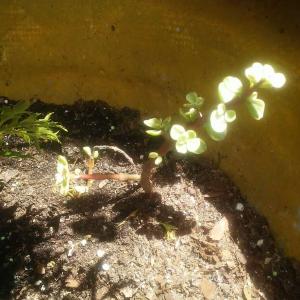成长记
Ophelia Darke
2017年09月03日

I new added a "String of buttons (Crassula Perfatora)" in my "garden"


0
0
文章
Dummer. ゛☀
2017年08月23日

The structural craziness of Crassula marnieriana makes it a standout plant for any grower’s collection. The succulent is known by many names, among them: Worm plant Chinese jade Jade necklace vine Baby necklace Lucky for us colder clime growers, this plant is hardy and can even withstand a light freeze. The genus Crassula may exceed 200 species. Crassula marnieriana is one of the most unique with vertical stacked thick leaves adorned on the edges with blushed pink. Here are a few tips on how to grow a jade necklace and experience the architectural beauty and Dr. Seuss form of the worm plant.

Jade Necklace Vine Info
Succulent lovers are probably familiar with the family of Crassula plants. Many of them are notable for their strange shapes and unusual stacked leaves. Crassula worm plants exemplify the fantastical structure of a living necklace, with stacked leaves placed perfectly one on top of the other. Words almost fail when trying to describe Crassula worm plants. Smaller specimens have erect, slender branches decorated with tiles of succulent leaves growing right on top of each other. Stems will rarely get longer than 8 inches, but the longer sections tend to droop and hang or even simply trail along the ground. Jade necklace vine is native to South Africa, Lesotho and Swaziland. Leaves are green with pink to rose edges, plump and tightly stacked on the stem much like beads on a string. If you are lucky, the plant produces tiny starry clusters of pinkish blooms.

How to Grow a Jade Necklace
The jade necklace worm plant is also a very easy plant to grow, provided you have enough sun and satisfy a few other conditions. Jade necklace worm plant is one of the easiest succulents to propagate and well worth the effort to create more of these eye-catching plants. As with most succulents, you can start new plants simply by cuttings. Seeds are available but adult forms of the plant take many years to grow. Cuttings should be allowed to callus for a few days to prevent rot. Then, simply insert the cutting into sand or other soilless media and keep moderately moist in a brightly lit area that is protected from scorching sun. Roots should form in just a few weeks. Once the plant is sufficiently established, it may be moved to a well-drained pot in good cactus or succulent soil. The next step is to follow good worm plant care so your new baby will thrive and delight you with a show of flowers and festively adorned stems.

Jade Necklace Worm Plant Care
Crassulas prefer sunny locations but they can tend to burn if in scorching sun’s rays. Jade necklace is resistant to drought and all but the coldest weather, so it makes a perfect patio plant for most regions. If freezes threaten, bring your plant indoors. The best soil is a well-drained mixture of sand or grit with peat and vermiculite or perlite. Choose a pot that evaporates excess moisture since wet roots and stems can spell a death sentence for Crassula. In summer, water the plant deeply every week and in winter water only once every 3 weeks. During the growing season, use a fertilizer formulated for succulents to promote health. Transplant the plant only when it outgrows its pot. Crassula are very tolerant of crowded conditions and can be very happy in their container for many years. Watch for mealybugs or scale and treat the plant with a good horticultural soap. Crassula plants need good air circulation to prevent mildew issues, but other than that these are some of the hardiest and easiest plants to grow. Add one to your collection for easy care beauty and interest.

Jade Necklace Vine Info
Succulent lovers are probably familiar with the family of Crassula plants. Many of them are notable for their strange shapes and unusual stacked leaves. Crassula worm plants exemplify the fantastical structure of a living necklace, with stacked leaves placed perfectly one on top of the other. Words almost fail when trying to describe Crassula worm plants. Smaller specimens have erect, slender branches decorated with tiles of succulent leaves growing right on top of each other. Stems will rarely get longer than 8 inches, but the longer sections tend to droop and hang or even simply trail along the ground. Jade necklace vine is native to South Africa, Lesotho and Swaziland. Leaves are green with pink to rose edges, plump and tightly stacked on the stem much like beads on a string. If you are lucky, the plant produces tiny starry clusters of pinkish blooms.

How to Grow a Jade Necklace
The jade necklace worm plant is also a very easy plant to grow, provided you have enough sun and satisfy a few other conditions. Jade necklace worm plant is one of the easiest succulents to propagate and well worth the effort to create more of these eye-catching plants. As with most succulents, you can start new plants simply by cuttings. Seeds are available but adult forms of the plant take many years to grow. Cuttings should be allowed to callus for a few days to prevent rot. Then, simply insert the cutting into sand or other soilless media and keep moderately moist in a brightly lit area that is protected from scorching sun. Roots should form in just a few weeks. Once the plant is sufficiently established, it may be moved to a well-drained pot in good cactus or succulent soil. The next step is to follow good worm plant care so your new baby will thrive and delight you with a show of flowers and festively adorned stems.

Jade Necklace Worm Plant Care
Crassulas prefer sunny locations but they can tend to burn if in scorching sun’s rays. Jade necklace is resistant to drought and all but the coldest weather, so it makes a perfect patio plant for most regions. If freezes threaten, bring your plant indoors. The best soil is a well-drained mixture of sand or grit with peat and vermiculite or perlite. Choose a pot that evaporates excess moisture since wet roots and stems can spell a death sentence for Crassula. In summer, water the plant deeply every week and in winter water only once every 3 weeks. During the growing season, use a fertilizer formulated for succulents to promote health. Transplant the plant only when it outgrows its pot. Crassula are very tolerant of crowded conditions and can be very happy in their container for many years. Watch for mealybugs or scale and treat the plant with a good horticultural soap. Crassula plants need good air circulation to prevent mildew issues, but other than that these are some of the hardiest and easiest plants to grow. Add one to your collection for easy care beauty and interest.
1
0
Ueca
2017年08月22日

An arrangement incorporating Echeveria, Sedum, Crassula, Graptopetalum, and Kalanchoe.


1
0
文章
Dummer. ゛☀
2017年08月17日

Collectors of succulents will be excited about Crassula pagoda plants. For sheer architectural interest, this unique plant evokes images of a trip to Shanghai where religious temples reflect the unimaginable forms of stacked architecture and astounding building prowess. Red Pagoda Crassula is an easy-to-grow plant that will add punch to any succulent display or as a stand-alone specimen. Here are a few tips on how to grow Red Pagoda and harness the impact of its structure and colorful foliage.

Red Pagoda Crassula
Succulents offer a wide range of form to suit any discernible gardener. The Crassula genus has over 150 different species, each more surprising than the last. The fairly common jade plant is in the genus. Crassula pagoda plants have an even more diverse “wow” factor. The stacked triangular foliage edged with red and fine prickly spines are eye candy for the succulent enthusiast. Growing Crassula Red Pagoda is a must for the gardener crazy about succulents and collecting.
Red Pagoda (Crassula corymbulosa) grows spirally arranged, thick fleshy leaves bordered with bright pink, red or sometimes orange. Once you get over the color, the geometric arrangement of the leaves will astound and amaze. The effect of the layered leaves is hard to describe without invoking artistic expression. Each new rosette of leaves grows on top of an older rosette. The new leaves are mostly green and small but they get larger and larger with brighter colors as you view down the plant’s stem. The effect is almost an optical illusion of looking into a deeply hued, ribbed tunnel. The plant is also called shark’s tooth due to the triangular serrated pads.

How to Grow Red Pagoda
Soil, light and air circulation are key needs for growing Crassula Red Pagoda. The stems are initially erect but over time, as new rosettes form, it will begin to trail. This means you can grow the plant in a hanging basket. It is equally at home in a rockery, clay pot or amongst a display of other succulents in the garden. Red Pagoda is only hardy in United States Department of Agriculture zones 11 to 12 but it performs well as a houseplant, too. Plants prefer well-drained soil with plenty of grit but can survive in amended clay soil. Like most succulents, Red Pagoda is easy to grow from cuttings. Allow the cutting to callus for a few days and insert into a soilless medium. In a month or so, the plant will root and can be transplanted to a display container or the garden.

Caring for Crassula Succulents
Red Pagoda gets its deepest, most vibrant color in winter in a bright location. Plants located in sun develop hues that are rich and jewel-like. The plant has low water needs but it is best to follow a regular schedule of watering in the first year to force a vigorous root system. Red Pagoda is both deer and rabbit resistant, thrives in drought conditions for short periods of time, can perform well in either full or partial sun and has low nutrient requirements. About the only thing that will kill the plant is overwatering, which causes root rot, and a few pests such as mealybugs and aphids. Remove the spent leaves to preserve the best appearance. Lazy gardeners will love caring for Crassula succulents due to their unfussy natures. Good care may see you rewarded in summer with lovely white flowers that are attractive to bees. Divide the plants every 2 or 3 years and share the gift of this unique plant.

Red Pagoda Crassula
Succulents offer a wide range of form to suit any discernible gardener. The Crassula genus has over 150 different species, each more surprising than the last. The fairly common jade plant is in the genus. Crassula pagoda plants have an even more diverse “wow” factor. The stacked triangular foliage edged with red and fine prickly spines are eye candy for the succulent enthusiast. Growing Crassula Red Pagoda is a must for the gardener crazy about succulents and collecting.
Red Pagoda (Crassula corymbulosa) grows spirally arranged, thick fleshy leaves bordered with bright pink, red or sometimes orange. Once you get over the color, the geometric arrangement of the leaves will astound and amaze. The effect of the layered leaves is hard to describe without invoking artistic expression. Each new rosette of leaves grows on top of an older rosette. The new leaves are mostly green and small but they get larger and larger with brighter colors as you view down the plant’s stem. The effect is almost an optical illusion of looking into a deeply hued, ribbed tunnel. The plant is also called shark’s tooth due to the triangular serrated pads.

How to Grow Red Pagoda
Soil, light and air circulation are key needs for growing Crassula Red Pagoda. The stems are initially erect but over time, as new rosettes form, it will begin to trail. This means you can grow the plant in a hanging basket. It is equally at home in a rockery, clay pot or amongst a display of other succulents in the garden. Red Pagoda is only hardy in United States Department of Agriculture zones 11 to 12 but it performs well as a houseplant, too. Plants prefer well-drained soil with plenty of grit but can survive in amended clay soil. Like most succulents, Red Pagoda is easy to grow from cuttings. Allow the cutting to callus for a few days and insert into a soilless medium. In a month or so, the plant will root and can be transplanted to a display container or the garden.

Caring for Crassula Succulents
Red Pagoda gets its deepest, most vibrant color in winter in a bright location. Plants located in sun develop hues that are rich and jewel-like. The plant has low water needs but it is best to follow a regular schedule of watering in the first year to force a vigorous root system. Red Pagoda is both deer and rabbit resistant, thrives in drought conditions for short periods of time, can perform well in either full or partial sun and has low nutrient requirements. About the only thing that will kill the plant is overwatering, which causes root rot, and a few pests such as mealybugs and aphids. Remove the spent leaves to preserve the best appearance. Lazy gardeners will love caring for Crassula succulents due to their unfussy natures. Good care may see you rewarded in summer with lovely white flowers that are attractive to bees. Divide the plants every 2 or 3 years and share the gift of this unique plant.
2
1
求助
succulentnewbie
2017年08月12日

Can anyone help me ID the first 4? Also if someone knows what's wrong with the last two, it would help me out a lot! Last one is a crassula sub species
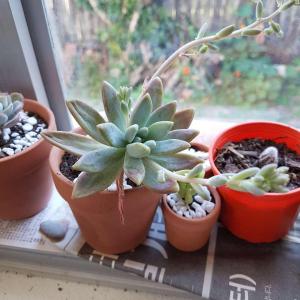
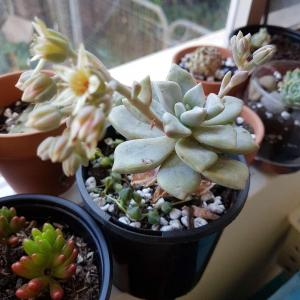
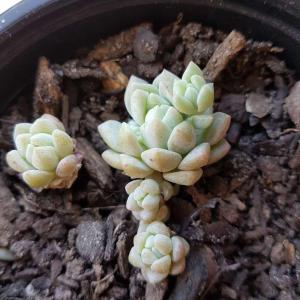







1
0
fearlessgrower:i agree, flapjack needs water
meriunkat:the first one is Graptosedum Francesco Baldi
Haleyfleeanne:Last two, looks like they need water.
Faith_adamsxxx
2017年08月11日

Got some new succulents today! would anyone be able to identify them for me? I know one of them is a Crassula Perforta :)






0
0
文章
Miss Chen
2017年08月08日

Succulents are often exotic-looking plants with thick, fleshy leaves and stems designed to store water and help the plants thrive in warm, dry areas. Succulents grow throughout the world and include such diverse plants as jade (Crassula argentea), which grows as a perennial outdoors in U.S. Department of Agriculture plant hardiness zones 10 through 11, and greenii hens and chicks (Sempervivum tectorum subspecies greenii), which is hardy in USDA zones 4 through 9. Although certain succulents must be moved indoors during the winter months in some U.S. locations, many thrive outdoors in even very cold temperatures when they receive proper care.

Plant Winter-Hardy Varieties
Choose winter-hardy succulents for the easiest winter care. Those plants include greenii hens and chicks, hardy ice plant (Delosperma cooperi, USDA zones 5 through 11) and 'Golden Sword' yucca (Yucca filamentosa 'Golden Sword', USDA zones 4 through 9). Although these succulents may wither or change color during cold weather, that is normal, and you will not have to provide them with winter protection.
Keep the Soil Dry
In northern U.S. states, succulents need far less water during the winter months than they do in summer. Stop fertilizing and watering succulents in late fall to prevent hydrated plants from freezing during winter. During cold months, keep their soil as dry as possible, and ensure your succulents receive enough air circulation to prevent dampness. If the soil around your succulents appears wet, then add sand to the soil to keep the plants' roots dry. A mixture that is one-third loam, one-third sand and one-third peat moss is reliable.
Protect Them from Frost
If freezing temperatures are expected, cover the succulents with fabric, such as an old bed sheet, or with a frost cloth, which is available from plant nurseries. Completely cover the succulents with the material, and place cinder blocks or other heavy objects on the material's edges to keep it in place. Avoid using a plastic cover, which prevents air circulation and makes sunlight too intense for plants.

As soon as the danger of frost passes, remove the material to encourage air circulation and provide sunlight.
Relocate Them as Needed
If your succulents are in pots, then place them in the most ideal conditions possible for cold weather. For example, put the potted plants in a sunny location under a porch or eaves if winters in your area are rainy. If temperatures become cooler than normal, place the container succulents near boulders, shrubs or walls that face south or west; those structures and plants retain heat.
Another option is to move potted succulents indoors to help them thrive during frosty weeks or months. Place them in front of a bright, sunny window, and water their soil to prevent the plants from withering; water thoroughly, until water comes out the pots' bottom drain holes. Allow the soil to dry out completely before you water again.
Do not fertilize the succulents during the winter months.

Plant Winter-Hardy Varieties
Choose winter-hardy succulents for the easiest winter care. Those plants include greenii hens and chicks, hardy ice plant (Delosperma cooperi, USDA zones 5 through 11) and 'Golden Sword' yucca (Yucca filamentosa 'Golden Sword', USDA zones 4 through 9). Although these succulents may wither or change color during cold weather, that is normal, and you will not have to provide them with winter protection.
Keep the Soil Dry
In northern U.S. states, succulents need far less water during the winter months than they do in summer. Stop fertilizing and watering succulents in late fall to prevent hydrated plants from freezing during winter. During cold months, keep their soil as dry as possible, and ensure your succulents receive enough air circulation to prevent dampness. If the soil around your succulents appears wet, then add sand to the soil to keep the plants' roots dry. A mixture that is one-third loam, one-third sand and one-third peat moss is reliable.
Protect Them from Frost
If freezing temperatures are expected, cover the succulents with fabric, such as an old bed sheet, or with a frost cloth, which is available from plant nurseries. Completely cover the succulents with the material, and place cinder blocks or other heavy objects on the material's edges to keep it in place. Avoid using a plastic cover, which prevents air circulation and makes sunlight too intense for plants.

As soon as the danger of frost passes, remove the material to encourage air circulation and provide sunlight.
Relocate Them as Needed
If your succulents are in pots, then place them in the most ideal conditions possible for cold weather. For example, put the potted plants in a sunny location under a porch or eaves if winters in your area are rainy. If temperatures become cooler than normal, place the container succulents near boulders, shrubs or walls that face south or west; those structures and plants retain heat.
Another option is to move potted succulents indoors to help them thrive during frosty weeks or months. Place them in front of a bright, sunny window, and water their soil to prevent the plants from withering; water thoroughly, until water comes out the pots' bottom drain holes. Allow the soil to dry out completely before you water again.
Do not fertilize the succulents during the winter months.
3
4





